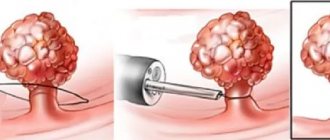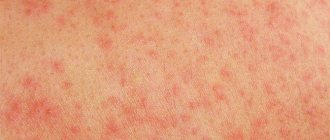Our skin is constantly in contact with a large number of allergens, so skin allergies are one of the most common types.
A group of diseases in which the main symptoms are skin allergies are called allergic dermatoses. These include diseases such as urticaria, allergic contact dermatitis, atopic dermatitis, eczema, toxicerma, etc.
What is an allergy
An allergy is the body's reaction to contact with substances that our immune system recognizes as hostile. This does not mean that birch pollen, peanuts, wheat, milk protein or any other allergen are actually dangerous. For most, they are harmless, but in people with high sensitivity they cause unpleasant allergies.
The more man-made pollutants in the environment (from diesel fuel combustion products to sulfur dioxide), the higher the risk of allergies in children and adults, since the protective epithelium in the nasopharynx, larynx and bronchi is damaged due to inhalation of harmful impurities.
It is believed that such an immune response to external stimuli occurs due to the absence of other, more serious diseases (autoimmune and allergic diseases are rare among residents of poor countries). This fine-tuning of the body helps reduce the risk of cancer - in people with allergies, the immune system quickly detects cancer cells and begins to fight the tumor, preventing it from growing.
Causes
Patients with allergies always have a hereditary predisposition to its occurrence. Among relatives there will definitely be allergy sufferers, and their allergies can manifest themselves in different ways: skin, food, allergic rhinitis, bronchial asthma - the form does not matter.
To develop the clinical picture, exposure to a sensitizing substance—an allergen—is necessary. They can be dust, pollen, chemicals in detergents, clothing, hazardous industries, some food products, medicines, etc., as well as substances formed in the body itself under the influence of cold or sunlight, metabolic products of parasites.
How does it manifest itself?
According to the Institute of Immunology, up to 30% of Russians suffer from various allergy symptoms. The most common include:
- runny nose,
- sneezing,
- tearfulness,
- skin rash,
- itching,
- edema,
- increase in temperature at the site of inflammation.
The first five signs are caused by our body’s desire to quickly get rid of the “enemy”, so sometimes vomiting can be added to the symptoms. The rest also reflect an active fight against the pathogen.
Research by the World Allergy Organization has shown that in Germany there are 40% of allergy sufferers, in the UK - 44%, and in Denmark, as well as in Russia, so far no more than 30%.
Specific and individual allergens IgE and IgG
The cause of allergic reactions is the impact on the human body and its defenses of individual allergens. Experts identify several types of allergens, for the determination of which appropriate conditions must be created.
Allergens IgG
Substances of this type are the cause of food intolerance, that is, a delayed allergic reaction, which about 20% of the world's population experiences from time to time. A reaction can occur several hours, and sometimes even days, after consuming a particular product. In this case, it becomes much more difficult to determine the substance that provoked the body’s negative response.
Allergens IgE
Acute IgE food allergy periodically affects 2–3% of the world's population. In this case, any food products can act as individual allergens. The reaction often develops very quickly - within 5-15 minutes from the moment the aggressive substance enters the body. The most dangerous manifestations of food allergies are anaphylaxis and choking.
Individual IgG allergens
Research to determine individual allergens must be comprehensive. If the test shows that the patient's IgE level is within the normal range, an IgG test should be performed. Factors that need to be taken into account are:
- seasonality of manifestations;
- region of residence;
- type of individual allergen;
- patient's age.
The cause of any chronic disease can be precisely the increased content of the IgG allergen. Do not forget that an allergic reaction to the smell of food often manifests itself in the form of a cough.
Read material on the topic: How to choose a diet: correctly and effectively
Development mechanism
How does an allergy appear? What makes the immune system ruin our lives with unbearable itching and an endless stream of tears?
After the first contact with an allergen, the body produces specific antibodies, which remain in the blood until the next “meeting”. As soon as the immune system encounters this substance again and recognizes it, it begins to act: a whole complex of mediators is sent to fight, including histamine, heparin and serotonin.
It is histamine that causes such typical symptoms and signs of allergies as a local increase in temperature and redness of the skin as a result of spasm of the bronchial muscles and vasodilation. The work of heparin is to stimulate the production of the hormone bradykinin, which causes swelling and other anaphylactic manifestations, and the familiar “happiness hormone” serotonin is responsible for the production of lymphocytes.
In smokers, the symptoms of allergic reactions are more pronounced because nicotine is a powerful release of histamine from cells.
Diagnosis of individual allergens
Today, using a comprehensive assessment of IgG-dependent food allergies, you can evaluate your own body’s reaction to 88, 90 and 190 foods and identify which of them are your individual allergens. The answer in the study results can be low, medium or high.
Having become the owner of a document confirming the presence of specific antibodies to certain food allergens, the patient should completely stop consuming them for a long period of time (from 3 months to six months). Subject to strict adherence to the diet, the concentration of allergen-specific immunoglobulins decreases, as a result of which the test gradually becomes negative.
In 70% of cases, eliminating individual allergens from the diet allows you to achieve a positive clinical effect, significantly improve the patient’s condition, or completely recover from the disease.
For many patients who have suffered from unexplained pain for a long time, testing for an individual IgG-dependent allergen becomes a real salvation. To achieve lasting improvement, it is necessary to exclude individual allergens from the diet for 3-6 months. After this, thanks to the elimination of toxic immune complexes, most patients consume foods that were previously dangerous every 3-4 days without any harm to health.
An elimination diet can also help you lose excess weight. Reviews from many patients indicate not only weight correction, but also an improvement in the condition of the body as a whole.
The level of identification of food allergens by determining specific IgG and IgE is 90% higher than by provocative testing. Conversely, if information on specific immunoglobulins and skin test results are combined, the number of identified allergens will not increase. To confidently talk about the presence of an allergy, it is necessary to conduct a series of tests for immediate and delayed hypersensitivity.
But there are also special cases of a severe reaction of the body to the influence of an individual allergen, when the patient should adhere to a diet even with negative results of repeated tests.
Allergy tests:
- A skin test performed on the back or forearm. The analysis is inexpensive, quick and painless, which makes it popular among patients. At the same time, in parallel with the skin test, due to its insufficient information content, a blood test is often performed. Having marked the required areas of the skin, the medical professional applies the allergen to them using injections, test strips or micro-scratches.
- A blood test for antibodies (immunoglobulins), which not only detects allergies, but also identifies the allergen. This test is expensive, but at the same time highly informative. A special panel of individual allergens includes a huge variety of probable allergy triggers.
- A blood test for eosinophils, which serve as indicators of an allergic reaction. In a healthy body that does not suffer from allergies, their level is 1–5% of all blood cells. If this figure exceeds 5%, there is a disorder of the immune system that provokes an allergic reaction. An additional analysis for immunoglobulins will allow us to make an unambiguous conclusion that it was allergies that caused the increase in the level of eosinophils in the blood.
- Provocative tests are used exclusively in cases where other tests have failed. The type of provocative test is determined by the allergic reaction that worries the patient. For conjunctivitis, an individual allergen is injected into the lacrimal gland, and for rhinitis - into the sinuses. The procedure is carried out only in the presence of a doctor in a hospital setting, because even a minimal amount of allergen can cause a severe reaction, which only medical workers can stop.
Read material on the topic: Lightening age spots
Types and symptoms of allergies
The most common types are respiratory, food and skin, although many people also suffer from medications and psychological causes.
Respiratory
How can respiratory allergies manifest themselves? The list of symptoms includes a runny nose, itching in the sinuses, larynx and even ears. Additional signs include a dry cough, sore throat, frequent sneezing, red eyes and watery eyes. The causes may be different allergens.
Pollen from birch, poplar, ragweed, alder, wormwood, etc. Seasonal pollen allergies are called hay fever, or hay fever, as it was thought to develop due to inhalation of the smell of hay. Symptoms disappear immediately after the allergen stops blooming (trees and shrubs bloom in spring, grasses bloom in summer).
How to find out what an adult is allergic to? Only experimentally or by testing, since different types of pollen produce different Ig E immunoglobulins, and the allergic reaction will be expressed equally. In children, hay fever appears as early as 3–4 years of age; if it is ignored, complications may arise and bronchial asthma may develop.
Almost 150 million Europeans suffer from allergies. In Russia, according to the Ministry of Health, susceptibility to pollen varies in different regions and ranges from 30 to 75%, while in the Amur region, flowering negatively affects almost 90% of residents. For allergy sufferers, special websites have been developed showing the distribution of pollen from different plants on a map of Russia (among the well-known: pollen.club, myallergo.ru and allergotop.com).
To eliminate the negative impact, during the flowering period:
- close the windows, and if you open them, hang damp curtains and tulle;
- do not dry clothes outdoors;
- wear glasses;
- protect your respiratory system with a mask;
- take a shower after every time you go outside;
- Avoid walking in nature (in parks, forests, fields).
If hay fever is caused by tree pollen, eliminate stone fruits, nuts, honey and red apples from your diet.
Wool. Cats or dogs, as well as horses and parrots, can cause unpleasant allergy symptoms (red eyes, itching, sneezing, allergic rhinitis, excessive lacrimation). A reaction solely to fur occurs less frequently than to skin particles, saliva, or waste products.
The absence of carpets in the apartment, the allocation of a separate room for pets, thorough washing of animals at least twice a month (if this does not contradict the recommendations of a veterinarian), if possible during an exacerbation period, do not keep them at home, but send them to live with friends or in hotel.
If you have animals at home and you are expecting a guest with allergies, do not vacuum or dust on this day - dust with allergens will not rise into the air, and it will be easier for your guest to breathe.
Dust mites. The immune response manifests itself in the form of sneezing, dry cough, conjunctivitis. Since dust mites love carpets, pillows, upholstered furniture and toys, as a protective measure it is necessary to do wet cleaning at least once a week, refuse carpets and fabric curtains, use vacuum cleaners, supply ventilation devices with an air purification function or purifiers-disinfectants with HEPA filters.
Skin
They are caused by some food products, household chemicals and cosmetics. Typical signs of an allergic reaction include peeling, redness and rashes, and infants may experience diaper rash. There are three main forms:
- hives. Characterized by the appearance of blisters resembling a nettle burn;
- eczema. In addition to swelling and changes in skin color, small blisters grouped in certain areas are characteristic;
- atopic dermatitis. A more serious form of eczema that requires special attention. In children, it appears as a red rash on the cheeks due to diathesis. Infantile atopic dermatitis usually causes the transition from breastfeeding to formula milk at 3 to 4 months of age. At the age of two, foci of the disease can be visible on the buttocks, neck, under the knees, and in the armpits. In adults, mycosis and herpes can be diagnosed against the background of atopic dermatitis.
If redness appears on the skin, doctors recommend immediately changing washing powder, fabric softener or household chemicals; only hypoallergenic products are allowed for washing clothes and diapers for infants. To eliminate the negative impact of cosmetic products, read the manufacturer’s instructions in detail, test the cream or paint on a small area, cleanse your skin regularly, do not leave decorative cosmetics on overnight, and pay attention to the expiration date.
Food
How do allergies to milk, honey, nuts, fish, berries, citrus fruits, food additives and other foods manifest themselves? The first symptoms are itching, swelling of the tongue, and redness of the skin. If you continue to consume allergens, they can cause:
- intestinal disorders (vomiting, diarrhea, colic, constipation, nausea);
- skin rash;
- anaphylactic shock.
Sometimes food allergies are accompanied by a runny nose or conjunctivitis.
You can reduce the likelihood of unpleasant symptoms by eliminating allergen-containing foods from your diet. If you are visiting or going to a restaurant, choose the simplest possible dishes with a small number of ingredients. How to identify an allergy to a specific product? Doctors recommend keeping a food diary and recording your observations and feelings in it.
Although there are many food allergens, in 90% of cases the body's severe immune response is caused by soy, dairy products, fish, shellfish, chicken eggs, peanuts or tree nuts.
Medicinal
One of the most dangerous types, as it more often than others leads to Quincke's edema and anaphylactic shock. It may also appear:
- swelling of the upper respiratory tract,
- vomiting,
- drop in blood pressure,
- nasal congestion,
- hives,
- itching,
- rash,
- redness,
- wheezing.
Drug allergies can be caused by antibiotics (including penicillin), aspirin, analgin, sulfa drugs, local anesthetics and other groups of medications. Before using medications, carefully study the information about contraindications, and before procedures in the hospital, be sure to tell doctors about all allergens to which you are susceptible.
Psychological
If all the types described above were the body’s response to direct contact with a foreign substance-irritant, then the psychological reaction is associated with emotional experiences. For example, if a person once experienced unpleasant emotions while eating oranges, then he may develop a subconscious allergy to citrus fruits, which has nothing to do with their chemical composition. Perhaps it is psychological factors that determine such unusual types of body reactions as an allergy to Wi-Fi.
An immune response can also be provoked by insect bites (wasps, bees and ants inject poison under the skin, to which our immunity reacts), mold, fungal spores and other allergens.
Dietary recommendations for allergies
Hypoallergenic products are safe for most allergy sufferers. Following a hypoallergenic diet is not easy due to quite large restrictions. And yet, it is quite possible to choose a diet that will be enjoyable; the main thing is to determine what substance you are allergic to. But remember that only a specialist can create the optimal diet for you.
First of all, exclude foods to which you have individual intolerance and the strongest allergens.
:
- Eggs
- Wheat
- Fish
- Nuts
- Peanut
- Crustaceans (shrimp, crabs, lobsters)
- Citrus
- Chocolate
- Red fruits and berries
- Soybeans
- Honey
We recommend
“Amount of protein: content in food products and consumption rate” Read more
Listed below are foods that are statistically less likely to cause an allergic reaction. They can be combined with each other and thus create a unique menu for every day
:
- All types of vegetables (as many as possible, including the whole rainbow of colors in the diet)
- Herbs, greens and spices.
- High-quality meat (grass-fed) and poultry (not much, due to the content
- omega-6).
- Healthy fats (butter, avocado oil, coconut oil)
- Fruits (no more than 40 g of fructose per day, 20 g is optimal).
- Fermented foods
Try to choose the highest quality products possible and eat as much variety as possible.
How long should you follow the diet?
As a rule, the diet is prescribed for a period of one to two weeks and the effect is monitored. After the symptoms subside, the diet should be gradually expanded, adding previously excluded foods, but you need to ensure that they do not contain artificial food additives: dyes, preservatives, emulsifiers - they irritate the gastrointestinal tract.
If you suspect you have a food intolerance to a particular food, an elimination diet may be appropriate.
An elimination diet is a short-term eating plan that eliminates certain foods that can trigger negative digestive reactions. Next, the products are reintroduced one at a time to determine which ingredients are well tolerated by the body and which are not.
The procedure is as follows
:
- Select the product you want to test your body's tolerance to it. Be prepared to eat it 2-3 times a day and then avoid it for several days.
- The first time you try food, start with half a teaspoon or less. Wait 15 minutes.
- If symptoms already begin, put the product aside. If nothing happens, eat another whole teaspoon or piece of this product. Wait 15 minutes again.
Possible symptoms
:
- Symptoms of your illness return or get worse.
- Gastrointestinal symptoms: abdominal pain, heartburn, nausea, constipation, diarrhea, change in frequency of bowel movements, flatulence, undigested food particles in the stool.
- Energy: Decreased energy, feeling tired, low energy in the afternoon along with increased energy in the evening, preventing you from falling asleep at the right time.
- Headache.
- Dizziness.
- Increased mucus - runny nose, nasal congestion.
- Desire to cough and clear throat.
- Itching in the eyes or mouth.
- Sneezing.
- Pain in muscles, joints and ligaments.
- Changes in the skin: rash, acne, dryness, redness.
- Mood problems: frequent changes or depressed mood.
- Fog in the head.
- Feeling restless.
- If symptoms begin, put the product aside. If not, then continue taking the product, increasing the volume to 1.5 teaspoons or a slightly larger piece.
- Leave it at that for now. Wait 2-3 hours after eating and monitor for symptoms during this time.
- After the time has elapsed, eat a full portion of this product either as a separate dish or as part of breakfast/lunch/dinner.
- After this, do not eat this product for 5-7 days and do not add any other trigger foods. Monitor your symptoms.
- If you do not experience any symptoms during the first trial day and then after 5-7 days, you can include this product in your diet.
We recommend
“Rational nutrition: principles and features” Read more
Unfortunately, it is not always possible to prevent the body from being exposed to an allergen. However, in cases where this can be achieved, the course of the disease improves significantly.
Here are some ideas for a hypoallergenic diet menu
:
- Cooked whole grains (from brown rice, buckwheat, millet or quinoa). You can add some coconut, ghee and/or cinnamon. To increase your protein intake, drink a drink with rice protein powder.
- Homemade potatoes: Cut onions, peppers, broccoli, mushrooms and other vegetables into small pieces as desired and sauté them in olive oil or ghee. Cut the pre-steamed potatoes into cubes and add to the vegetables. Add salt/pepper/herbs/spices.
- Large salad with chicken or fish. Serve with gluten free bread/baked potato/pumpkin.
- Baked salmon and steamed or oven-roasted vegetables with cooked millet, baked potato/sweet potato or quinoa salad.
- Baked or steamed halibut, baked winter squash sprinkled with cinnamon and ghee, fresh green salad.
- Brown rice and chicken, sautéed spinach or any other greens, baked potatoes or sweet potatoes.
- Chicken breast dusted with garlic powder and tarragon, steamed asparagus or broccoli, brown/wild rice or buckwheat porridge, ghee or olive oil.
- Quinoa with chicken and vegetable soup or vegetable soup.
- Chicken salad: chicken, various greens, guacamole, millet with pine nuts.
- Braised turkey breast, brown or wild rice, steamed vegetables, salad with French dressing.
Conclusion
:
Before starting treatment, it is important to understand the mechanism of allergic reactions. This makes it more likely to come up with an effective and efficient plan to combat not only the symptoms, but also the causes of your allergic reaction. No matter how unpleasant and dangerous they may be, there is no need to “wind up” yourself once again. After all, the more nervous you are, the more severe the allergy can be.
Differences from Covid-19
Due to the 2020–2021 pandemic. not everyone knows how to understand whether you have an allergy or a coronavirus infection. We present the main differences in the table.
| Symptom | Allergy | Covid-19 |
| Runny nose | ||
| Frequent sneezing | ||
| Tearing | ||
| Itching in the sinuses, eyes, mouth | ||
| Headache | ||
| Muscle pain | ||
| Impaired sense of smell | ||
| Loss of taste | ||
| A sore throat | ||
| Increase in body temperature above 38˚C | ||
| Cough with difficulty breathing | ||
| Weakness |
The given characteristics are enough not to confuse the signs of allergies and coronavirus infection and not to panic by calling an ambulance due to allergic rhinitis.
What is the best allergy medicine?
Today's pharmaceuticals produce a lot of allergy medications that help relieve symptoms and even partially eliminate the cause of allergic reactions. In pharmacies you can find tablets, injection solutions, sprays, ointments and other drug options. Let's see which ones are the most effective.
Allergy tablets
When talking about allergy pills, they usually mean antihistamines or receptor blockers:
- H1 - blockers for the relief of allergic symptoms of the skin, eye and respiratory type.
- H2 - blockers for the relief of gastroenterological manifestations.
The most common tablets are H1 receptor blockers; there are already three generations of these drugs. I generation: available drugs such as Tavegil, Suprastin, Peritol, Diphenhydramine, Pipolfen, Diazolin. They give a quick and short-term effect, but as a side effect they cause drowsiness.
Second generation drugs are Zyrtec, varieties of Cetirizine, as well as Loratadine, Ebastine, Astemizole and Acrivastine. They do not have a sedative effect, they can be taken 1 tablet per day and are approved for use during pregnancy.
Allergy tablets of the new generation are Telfast, Gifast, Beksist-sanovel, Fexofast, Allegra, Fexadin, Allerfex, Telfadin. In addition to the antihistamine, they have an anti-inflammatory and symptomatic effect. They are approved for long-term use, are not addictive and do not lose their therapeutic effectiveness.
Allergy shots
Sometimes allergy symptoms are severe, and pills alone are not enough for treatment. In this case, steroid drugs, available in the form of an injection solution, come to the rescue. Intramuscular administration is more effective than oral administration, so an injection of the drug works faster and better than a tablet.
Allergy nasal spray
If the allergy occurs as allergic rhinitis, then the very first action that can alleviate the condition is the use of a vasoconstrictor spray. They help instantly relieve swelling of the mucous membrane and restore nasal breathing. As a rule, allergy nasal sprays are used in combination with other medications, but can also be used as a stand-alone treatment for allergic or vasomotor rhinitis.
Allergy eye drops
Allergic conjunctivitis can seriously spoil life: swollen, red eyelids, constant watery eyes, itching and burning in the eyes. Of course, in the case of any allergy, it is necessary to look for its cause and treat it comprehensively, but conjunctivitis can be quickly removed with the help of drops.
Allergy eye drops help normalize the condition of the eye mucosa. They relieve swelling, eliminate burning and itching, and help stop lacrimation. Eye drops are available without a prescription and very quickly help relieve unpleasant symptoms. These are effective and safe products of the latest generation.
The Pharmacy pharmacy chain offers a wide range of products for symptomatic and general treatment of allergies. Consult your doctor and come to us: we will select all the necessary medications for you. Choose the Pharmacia pharmacy closest to you or place your order online. Phone for inquiries: +7 (391) 2911-555.
Diagnosis and treatment of allergies
Since allergy symptoms are milder in adults than in children, it can easily be confused with a common cold. It is better to consult a doctor immediately to avoid worsening the condition.
An allergist will help you cope with the disease - he will conduct a full examination, prescribe tests to identify the allergen and determine an effective treatment method, taking into account concomitant diseases. Standard diagnostic methods include a harmless blood test from a vein to check the reaction to various antigens, patch, scarification and other allergological tests, as well as prick tests with a puncture of the skin under a drop of the allergen. These studies are considered safe for people of any age, and most of them can be administered during pregnancy.
Allergies cannot be cured completely; moreover, they can appear suddenly to a product or drug with which there were no problems before, but it is possible to block the symptoms or completely avoid their occurrence. Depending on the severity of the patient’s disease, the doctor may prescribe antihistamines, glucocorticosteroids, decongestants, etc. They have different durations of action and side effects on the body (for example, taking hormonal pills can cause weight gain).
An alternative to drug treatment is immunotherapy - to reduce sensitization (sensitivity), under the supervision of an immunologist, increasingly large doses of the allergen are gradually introduced to the allergic person.
Preparing for the test
In order for the result of immunoblotting to be as reliable as possible, you need to follow several rules for preparing for the analysis:
- Blood is donated during the period of remission. If you conduct an analysis during an exacerbation of allergies, it will be difficult to determine which allergen caused the disease due to the high level of total IgE, which will distort the results.
- The analysis is not performed in patients with viral or bacterial infections. It is also worth postponing the test in case of exacerbation of chronic diseases or poisoning.
- 3-5 days before the test you need to stop taking medications and antihistamines. If your health condition does not allow you to stop treatment, consult an allergist.
- A few days before the test, you need to exclude contact with pets.
- A week before the test, it is necessary to exclude the most allergenic foods from the diet (honey, chocolate, nuts, citrus fruits, red fruits and berries, foods with preservatives and dyes, carbonated drinks).
- The day before the test, you should avoid strenuous physical activity, drinking alcohol, and smoking.
- You need to donate blood on an empty stomach, with your last meal at least 10 hours before taking blood.
Compliance with these rules allows you to conduct an allergy test with maximum accuracy and avoid false positive results. Your medical
Go to services and prices >>
What is the difference between IgG and IgE allergens?
The main difference lies in the clinical picture of the disease, namely how quickly its symptoms appear after consuming an individual allergen. An increased level of IgG allergen is a sign of food intolerance, the manifestations of which become noticeable only after a certain period of time (from several hours to 2-3 days). The symptoms in this case are not acute and do not pose a threat to human life, including indigestion or stool disorder, rash.
If the content of an individual allergen is high, reactions of types 2, 3 and 4 may occur. Skin tests, unlike IgE allergen tests, indicate a negative result. An allergic reaction can be caused not only by consuming a product in large quantities, but also by mixing various substances.
The IgE allergen leads to the rapid occurrence of acute reactions that are life-threatening in the skin or respiratory system:
- hives;
- swelling of the mucous membranes of the mouth and larynx;
- asthma attacks;
- dyspnea;
- Quincke's edema;
- anaphylactic shock.
The reaction occurs after consuming a minimal amount of a dangerous product, and the results of skin tests are positive.
If you have a question about the need to conduct an analysis for individual allergens, the specialists of the Veronica Herba City Beauty and Health Center will help you in the shortest possible time.
At the Center, highly qualified professionals are at your service, ready to tell you everything you need to know about individual allergens. They will also help you create an algorithm for an individual course of combating allergic reactions.
There are two such centers in Moscow – near Timiryazevskaya metro station and Otradnoye metro station.
Why clients choose Veronika Herba Beauty and Health Center:
- This is a beauty center where you can diagnose your body for individual allergens at a reasonable cost, and you will be treated not by an ordinary specialist, but by one of the best dermatologists in Moscow. This is a completely different, higher level of service!
- You can receive qualified help at any time convenient for you. The beauty center is open from 9:00 to 21:00, seven days a week. The main thing is to agree with your doctor in advance on the date and time of your appointment.
Sign up for a consultation with a specialist by phone +7 (495) 085-15-13
, and you will see for yourself!








